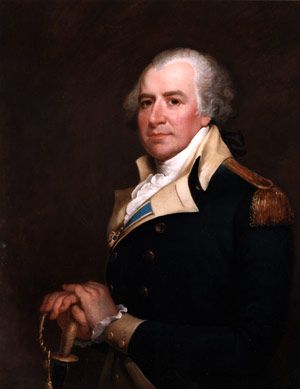Governor Thomas Mifflin
Term
December 21, 1790 - December 17, 1799
Affiliation
No Party Affiliation
Born
January 10, 1744
Died
January 20, 1800
 Photo courtesy of Capitol Preservation
Photo courtesy of Capitol PreservationCommittee and John Rudy Photography
Biography
Thomas Mifflin, Pennsylvania's first governor under the Constitution of 1790, was born in Philadelphia January 10, 1744, the oldest son of John and Elizabeth (Bagnell) Mifflin, a prosperous merchant family and early Quaker settlers. Mifflin graduated from the College of Philadelphia in 1760, worked for Philadelphia merchant William Coleman, and married Sarah Morris on March 4, 1765. With the Revolution approaching, Mifflin was known as a fiery Whig speaker, although he urged a moderate approach. Silas Deane later proclaimed Mifflin to be the "Soul of Philadelphia." Mifflin's popularity helped him become a member of the Pennsylvania Assembly from 1772 to 1776 and the First Continental Congress until hostilities erupted with Great Britain.
He entered the Continental Army and was the quartermaster general until 1778, a decision that brought him into personal religious conflict, causing him to be dismissed from his Quaker Meeting for participating in military action. In June 1775, then Major Mifflin became George Washington's aide-de-camp, rose the rank of major general, but fell into disfavor with Washington when Mifflin, after Philadelphia fell to British occupation, become involved with those attempting to replace General Washington with General Horatio Gates. Mifflin served in Congress from 1782 to 1784 and served as a member of the federal Constitutional Convention of 1787, as well as chairman of the Pennsylvania Constitutional Convention of 1789-90. Between the Revolution and the Pennsylvania's Constitution of 1790, the Commonwealth was governed by the Supreme Executive Council, of which Mifflin served as its president from 1788 to 1790. On December 21, 1790 Mifflin was officially the last president of Pennsylvania and the first governor of the Commonwealth.
Although he had no party label, the Federalist Party placed Mifflin for governor before the voters in 1790 and he easily defeated General Arthur St. Clair. In two reelection bids, Mifflin defeated Frederick A. Muhlenberg by a two to one margin in 1793 and by a thirty to one margin in 1796. During the Whiskey Rebellion of 1794 in western Pennsylvania, the governor objected to President Washington directly summoning the state militia. Mifflin established a state right in making the direct decision to use state militia as he did to suppress the Whiskey Rebellion in 1794 and Fries Rebellion in 1798. During Mifflin's administration, state political parties were organized and state government began to regulate banking and transportation. Mifflin also moved Pennsylvania from a Federalist state to a powerful center of Jeffersonian Republicanism. Although his third and final term in office was plagued by chronic illness and financial problems, as well as dealing with a Yellow Fever epidemic in Philadelphia, Mifflin was credited with pulling Pennsylvania out of its Revolutionary War debt, establishing a model penal code, and undertaking many public works projects.
Creditors descended on Mifflin in 1799 and he died penniless and with no heirs on January 20, 1800, just a little over one month after leaving office. Thomas Mifflin is buried in the cemetery of the German Lutheran Church in Lancaster. Mifflin County, formed on September 19, 1789, is named in honor of the first governor.
Pages in this Section
- 1790-1876
- Thomas Mifflin
- Thomas McKean
- Simon Snyder
- William Findlay
- Joseph Hiester
- John Andrew Shulze
- George Wolf
- Joseph Ritner
- David Rittenhouse Porter
- Francis Rawn Shunk
- William Freame Johnston
- William Bigler
- James Pollock
- William Fisher Packer
- Andrew Gregg Curtin
- John White Geary
- John Frederick Hartranft